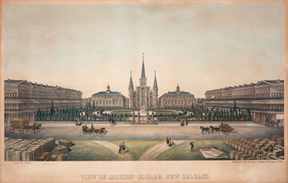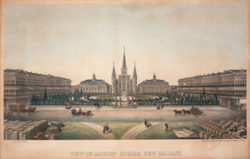Louis Lucien Pessou
Louis Lucien Pessou was one of the leading lithographers of antebellum New Orleans.

Courtesy of The Historic New Orleans Collection
View of Jackson Square, New Orleans. Dürler, J. (artist), Pessou & Simon (lithographers)
Louis Lucien Pessou was one of the leading lithographers of antebellum New Orleans, pioneering color lithography and creating an impressive body of work in the 1850s and 1860s. Along with painters Julien Hudson and Jules Lion and sculptor Florville Foy, Pessou was part of an antebellum community of free men of color trained as professional artists. Though free people of color lived elsewhere, New Orleans had the largest such group in the slave-holding South.
Though his exact circumstances of his birth are unknown, Pessou was born about 1825 and probably in New Orleans. The son of immigrants from St. Domingue, he was a member of the tight-knit Francophone group who reinforced New Orleans’ French identity. Pessou’s parents, both free people of color, had fled during the St. Domingue Revolution (also known as the Haitian Revolution), settling first in Cuba and then New Orleans. Their wedding was celebrated at St. Louis Cathedral. His father, Antoine Pessou, was a gunsmith with a shop on Royal Street; the family lived in the Tremé. All the children were born in New Orleans and became skilled craftsmen.
Louis Pessou was first listed as a lithographer in the 1853 New Orleans city directory. A year later he went into business with Benedict Simon, a German immigrant. Pessou and Simon soon became the leading lithographic firm in the city, producing hundreds of maps, plans, book illustrations, city views, and business forms. In the early years of the Civil War, they lithographed views of Camps Walker and Moore, and a copy of the Confederate Ordinance of Secession, interesting in view of Pessou’s race.
The partnership broke up in 1867, and Pessou briefly worked with another German lithographer. Then he took advantage of new employment opportunities open to African Americans in New Orleans under Reconstruction. In 1868, Pessou was named recorder of births and deaths for Orleans Parish; the duty of recording marriages was added to the position during his tenure. Until 1876, he continued to receive government appointments, acting as ward superintendent of streets for the third district and then as a city clerk. With the end of Reconstruction, Pessou returned to lithography, opening a studio in his Faubourg Marigny home.
Pessou died December 18, 1886. His death certificate listed him as “colored.” This is the sole contemporary reference to Pessou’s race, suggesting that he may not have been generally realized as an African American.
